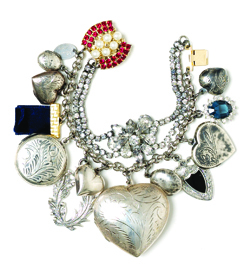charm bracelet on:
[Wikipedia]
[Google]
[Amazon]
 A charm bracelet is a type of
A charm bracelet is a type of
 In 1889,
In 1889,
 A charm bracelet is a type of
A charm bracelet is a type of bracelet
A bracelet is an article of jewellery that is worn around the wrist. Bracelets may serve different uses, such as being worn as an ornament. When worn as ornaments, bracelets may have a supportive function to hold other items of decoration, suc ...
which carries personal jewelled ornaments or "charms", such as decorative pendants or trinket
A trinket may refer to:
* A small showy piece of jewellery, such as a jewel or a ring.
* Trinket Island, an island of the Nicobar Islands
** Trinket (village), a village on the island
* Trinket snake, common name for '' Elaphe helena'', a species ...
s. The decorative ''charms'' usually carry personal or sentimental attachment by the owner.
History
The wearing of charms may have begun as a form ofamulet
An amulet, also known as a good luck charm or phylactery, is an object believed to confer protection upon its possessor. The word "amulet" comes from the Latin word amuletum, which Pliny's ''Natural History'' describes as "an object that protects ...
or talisman
A talisman is any object ascribed with religious or magical powers intended to protect, heal, or harm individuals for whom they are made. Talismans are often portable objects carried on someone in a variety of ways, but can also be installed perm ...
to ward off evil spirits or bad luck.
During the pre-historic period, jewellery charms would be made from shells, animal-bones and clay. Later charms were made out of gems, rocks, and wood.
For instance, there is evidence from Africa that shells were used for adornments around 75,000 years ago. In Germany intricately carved mammoth tusk charms have been found from around 30,000 years ago. In ancient Egypt charms were used for identification and as symbols of faith and luck. Charms also served to identify an individual to the gods in the afterlife.
During the Roman Empire
The Roman Empire ( la, Imperium Romanum ; grc-gre, Βασιλεία τῶν Ῥωμαίων, Basileía tôn Rhōmaíōn) was the post-Roman Republic, Republican period of ancient Rome. As a polity, it included large territorial holdings aro ...
, Christians
Christians () are people who follow or adhere to Christianity, a monotheistic Abrahamic religion based on the life and teachings of Jesus Christ. The words ''Christ'' and ''Christian'' derive from the Koine Greek title ''Christós'' (Χρι� ...
would use tiny fish charms hidden in their clothing to identify themselves to other Christians. Jewish scholars of the same period would write tiny passages of Jewish law and put them in amulets round their necks to keep the law close to their heart at all times. Medieval knights wore charms for protection in battle. Charms also were worn in the Dark Ages to denote family origin and religious and political convictions.
Charm bracelets have been the subject of several waves of trends. The first charm bracelets were worn by Assyrians, Babylonians, Persians, and Hittites and began appearing from 600 – 400 BC.
For example, Queen Victoria wore charm bracelets that started a fashion among the European noble classes. She was instrumental to the popularity of charm bracelets, as she “loved to wear and give charm bracelets. When her beloved Prince Albert died, she even made “mourning” charms popular; lockets of hair from the deceased, miniature portraits of the deceased, charm bracelets carved in jet.”
 In 1889,
In 1889, Tiffany and Co
Tiffany & Co. (colloquially known as Tiffany's) is a high-end luxury jewelry and specialty retailer, headquartered on Fifth Avenue in Manhattan. It sells jewelry, sterling silver, porcelain, crystal, stationery, fragrances, water bottles, wat ...
. introduced their first charm bracelet — a link bracelet with a single heart dangling from it, a bracelet which is an iconic symbol for Tiffany today.
Despite the Great Depression, during the 1920s and 1930s platinum
Platinum is a chemical element with the symbol Pt and atomic number 78. It is a dense, malleable, ductile, highly unreactive, precious, silverish-white transition metal. Its name originates from Spanish , a diminutive of "silver".
Platin ...
and diamonds were introduced to charm bracelet manufacturing.
Soldiers returning home after World War II brought home trinkets made by craftsmen local to the area where they were fighting to give to loved ones. American teenagers in the 1950s and early 1960s collected charms to record the events in their lives. Screen icons like Elizabeth Taylor
Dame Elizabeth Rosemond Taylor (February 27, 1932 – March 23, 2011) was a British-American actress. She began her career as a child actress in the early 1940s and was one of the most popular stars of classical Hollywood cinema in the 1950s. ...
and Joan Crawford
Joan Crawford (born Lucille Fay LeSueur; March 23, ncertain year from 1904 to 1908was an American actress. She started her career as a dancer in traveling theatrical companies before debuting on Broadway. Crawford was signed to a motion pict ...
helped to fuel the interest and popularity of charm bracelets.
Although interest and production waned through the latter part of the 20th century, there was a resurgence of popularity after 2000 and collectors eagerly sought out vintage charms. Inspired by the movie '' Pirates of the Caribbean'', bracelets with little charms of swords, crosses and skulls were introduced as a fashion trend during winter 2006.
Italian charm bracelets
A charm is a small ornament usually dangling from a bracelet or chain. However, the Italian charm bracelet is configured differently. While each charm is separate and interchangeable, it lies flat against the wrist and is interlocking to the next charm, similarly to an expansion band. A charm-link connecting tool is available to change the charms, but fingers seem to work just as well.See also
* Charivari (decorative chain)References
Bibliography
* * *External links
{{DEFAULTSORT:Bracelet, Charm Bracelets 1970s fashion 2000s fashion